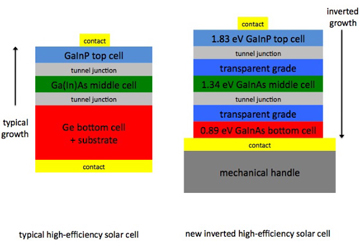The National Renewable Energy Laboratory of the U.S. Department of Energy
announced that it has achieved what it claims to be a world record photovoltaic cell conversion efficiency of 40.8%.
According to
NREL, its new solar cell differs significantly from those of the previous record holder,
Boeing Spectrolab, which boasted an efficiency of 40.7 and was also based on an
NREL design:
Instead of using a germanium wafer as the bottom junction of the device [as per a the previous design], the new design uses compositions of gallium indium phosphide and gallium indium arsenide to split the solar spectrum into three equal parts that are absorbed by each of the cell's three junctions for higher potential efficiencies. This is accomplished by growing the solar cell on a gallium arsenide wafer, flipping it over, then removing the wafer. The resulting device is extremely thin and light and represents a new class of solar cells with advantages in performance, design, operation and cost.
The following diagram, courtesy of NREL (via Semiconductor Times) depicts the improvements in NREL's new solar cell design:

It is also worth noting that this new observed efficiency mark was measured under concentrated light of 326 suns. One sun is about the amount of light that typically hits Earth on a sunny day. As a result, NREL notes that the new design is suited for "the space satellite market and for terrestrial concentrated photovoltaic arrays, which use lenses or mirrors to focus sunlight onto the solar cells."
Readers of this blog may recall that in July 2007, we reported that a group of researchers form the University of Delaware had claimed the world record for solar cell efficiency at 42.8%. In trying to reconcile these competing claims to the world record, spokespeople from both camps agree that comparing both systems is like comparing apples to oranges. Greentech Media details the reasons why.
Tapping into Infrared
In other research, scientists have developed new semiconductor materials that can tap into the previously unharnessed infrared spectrum of light in order to boost theoretical efficiencies to 63%.
Conventional semiconductors are silicon based and are only able to absorb light from the visible spectrum. Researchers led by Perla Wahnón at the Institute for Solar Energy at the Polytechnic University, and José Conesa at the Institute of Catalysis of the Spanish Higher Scientific Research Council, both in Madrid, Spain, have added titanium and vanadium in order to alter the electronic properties of semiconducting material to boost its theoretical conversion efficiency from 40%. The researchers emphasized that real-world conversion efficiencies would be less than these theoretical efficiencies.


2 comments:
what a wealth of information, but i am not a specialist of green energy, i am more in the Chinese cars.I have worked in ICE design company with chinese customers.
The National Renewable Energy Laboratory is so important to the future of the country. I have a friend that work in this place and he said me that NREL was the recipient of a rather large budget,I think that it is better than Buy Cialis!!!
Post a Comment